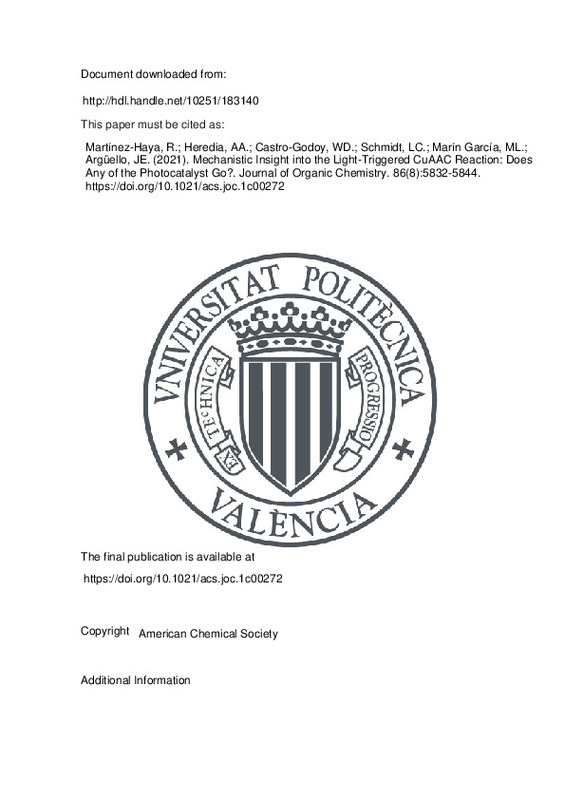JavaScript is disabled for your browser. Some features of this site may not work without it.
Buscar en RiuNet
Listar
Mi cuenta
Estadísticas
Ayuda RiuNet
Admin. UPV
Mechanistic Insight into the Light-Triggered CuAAC Reaction: Does Any of the Photocatalyst Go?
Mostrar el registro sencillo del ítem
Ficheros en el ítem
| dc.contributor.author | Martínez-Haya, Rebeca
|
es_ES |
| dc.contributor.author | Heredia, Adrian A.
|
es_ES |
| dc.contributor.author | Castro-Godoy, Willber D.
|
es_ES |
| dc.contributor.author | Schmidt, Luciana C.
|
es_ES |
| dc.contributor.author | Marín García, Mª Luisa
|
es_ES |
| dc.contributor.author | Argüello, Juan E.
|
es_ES |
| dc.date.accessioned | 2022-06-08T18:06:17Z | |
| dc.date.available | 2022-06-08T18:06:17Z | |
| dc.date.issued | 2021-04-16 | es_ES |
| dc.identifier.issn | 0022-3263 | es_ES |
| dc.identifier.uri | http://hdl.handle.net/10251/183140 | |
| dc.description.abstract | [EN] The attainment of transition-metal catalysis and photoredox catalysis has represented a great challenge over the last years. Herein, we have been able to merge both catalytic processes into what we have called "the light-triggered CuAAC reaction". Particularly, the CuAAC reaction reveals opposite outcomes depending on the nature of the photocatalyst (eosin Y disodium salt and riboflavin tetraacetate) and additives (DABCO, Et3N, and NaN3) employed. To get a better insight into the operating processes, steady-state, time-resolved emission, and laser flash photolysis experiments have been performed to determine reactivity and kinetic data. These results, in agreement with thermodynamic estimations based on reported data, support the proposed mechanisms. While for eosin Y (EY), Cu(II) was reduced by its triplet excited state; for riboflavin tetraacetate (RFTA), mainly triplet excited RFTA state photoreductions by electron donors as additives are mandatory, affording RFTA¿- (from DABCO and NaN3) or RFTAH¿ (from Et3N). Subsequently, these species are responsible for the reduction of Cu(II). For both photocatalysts, photogenerated Cu(I) finally renders 1,2,3-triazole as the final product. The determined kinetic rate constants allowed postulating plausible mechanisms in both cases, bringing to light the importance of kinetic studies to achieve a strong understanding of photoredox processes. | es_ES |
| dc.description.sponsorship | We acknowledge financial support from the Spanish Government (SEV-2016-0683), the Spanish Ministry of Science, Innovation, and Universities (Project PID2019-110441RBC33), the Generalitat Valenciana (Prometeo 2017/075), the Generalitat Valenciana, and the European Social Fund for postdoctoral contract (APOSTD2019-124 for R.M.-H.). R.M.H. We would also like to thank the financial support for a predoctoral contract from Apadrina la Ciencia Association and Ford Espana/Ford Motor Company Fund. We also acknowledge INFIQC-CONICET and Universidad Nacional de Cordoba (UNC). This work was partly supported by CONICET, SECyT-UNC, and FONCyT. | es_ES |
| dc.language | Inglés | es_ES |
| dc.publisher | American Chemical Society | es_ES |
| dc.relation.ispartof | Journal of Organic Chemistry | es_ES |
| dc.rights | Reserva de todos los derechos | es_ES |
| dc.subject.classification | QUIMICA ORGANICA | es_ES |
| dc.title | Mechanistic Insight into the Light-Triggered CuAAC Reaction: Does Any of the Photocatalyst Go? | es_ES |
| dc.type | Artículo | es_ES |
| dc.identifier.doi | 10.1021/acs.joc.1c00272 | es_ES |
| dc.relation.projectID | info:eu-repo/grantAgreement/AEI/Plan Estatal de Investigación Científica y Técnica y de Innovación 2017-2020/PID2019-110441RB-C33/ES/SINTESIS, CARACTERIZACION Y EVALUACION DE NUEVOS FOTOCATALIZADORES: ANALISIS DE PATOGENOS MICROBIANOS Y MICROCONTAMINANTES ORGANICOS COMO INDICADORES DE CALIDAD/ | es_ES |
| dc.relation.projectID | info:eu-repo/grantAgreement/MCIU//SEV-2016-0683/ | es_ES |
| dc.relation.projectID | info:eu-repo/grantAgreement/GENERALITAT VALENCIANA//PROMETEO%2F2017%2F075//REACCIONES FOTOQUIMICAS DE BIOMOLECULAS./ | es_ES |
| dc.rights.accessRights | Abierto | es_ES |
| dc.contributor.affiliation | Universitat Politècnica de València. Departamento de Química - Departament de Química | es_ES |
| dc.description.bibliographicCitation | Martínez-Haya, R.; Heredia, AA.; Castro-Godoy, WD.; Schmidt, LC.; Marín García, ML.; Argüello, JE. (2021). Mechanistic Insight into the Light-Triggered CuAAC Reaction: Does Any of the Photocatalyst Go?. Journal of Organic Chemistry. 86(8):5832-5844. https://doi.org/10.1021/acs.joc.1c00272 | es_ES |
| dc.description.accrualMethod | S | es_ES |
| dc.relation.publisherversion | https://doi.org/10.1021/acs.joc.1c00272 | es_ES |
| dc.description.upvformatpinicio | 5832 | es_ES |
| dc.description.upvformatpfin | 5844 | es_ES |
| dc.type.version | info:eu-repo/semantics/publishedVersion | es_ES |
| dc.description.volume | 86 | es_ES |
| dc.description.issue | 8 | es_ES |
| dc.identifier.pmid | 33825466 | es_ES |
| dc.relation.pasarela | S\446535 | es_ES |
| dc.contributor.funder | Ford Motor Company | es_ES |
| dc.contributor.funder | GENERALITAT VALENCIANA | es_ES |
| dc.contributor.funder | AGENCIA ESTATAL DE INVESTIGACION | es_ES |
| dc.contributor.funder | Universidad Nacional de Córdoba, Argentina | es_ES |
| dc.contributor.funder | Ministerio de Ciencia, Innovación y Universidades | es_ES |
| dc.contributor.funder | Consejo Nacional de Investigaciones Científicas y Técnicas, Argentina | es_ES |







![[Cerrado]](/themes/UPV/images/candado.png)

